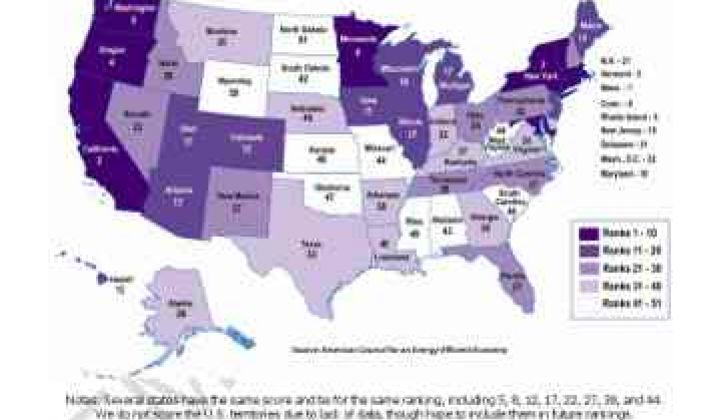Although the national economy is still slumping, energy efficiency spending continues to increase. Nationwide, states spent $5.5 billion in electricity and natural gas efficiency programs in 2010, compared to $3.4 billion the year before, according to the 2011 State Energy Efficiency Scorecard released on Thursday by the American Council for an Energy-Efficient Economy.
For the first time in the five years since the scorecard has been released, California was not in the top spot, falling behind Massachusetts in the rankings.
The spending was not just in a few states, but spread across the entire nation, with states such as Michigan and Tennessee making strong gains in efficiency measures. Twenty-four states have adopted Energy Efficiency Resource Standards and the ones that have had the standards for a few years are already seeing gains, according to the report.
The rankings are based on six areas of criteria: utility and public benefit programs, transportation policies, building codes, combined heat and power, state government initiatives, and appliance efficiency standards.
The top 10 was almost entirely unchanged from the previous year, with just one new addition.
1. Massachusetts
2. California
3. New York
4. Oregon
5. Vermont, Washington, Rhode Island, Minnesota, Connecticut (tie)
10. Maryland
The report noted that although the political environment these days is bitterly divisive, Republican-controlled states such as Colorado and Maine passed energy efficiency measures through their legislatures, as did Democratic states such as New York.
Maryland got itself into the top 10 (up from a ranking of 16 one year ago) by offering financial incentives for high-efficiency vehicles and from reaping the benefits of its EERS, adopted in 2008. The biggest mover of the year was Michigan, which went from number 27 to the number 17 spot. The Midwestern state has retooled its manufacturing sector, according to the report, with a newfound focus on efficiency and research and development of energy-efficient technologies.
Massachusetts overtook California with its aggressive Green Communities Act, which was passed in 2008. The initiative, which ACEEE called “the most aggressive EERS in the nation,” calls for a 2.4 percent savings in electricity sales and 1.5 percent for natural gas in 2012. The plan operates on three-year cycles. In most other categories Massachusetts and California earned similar points, although California still leads in transportation and appliance efficiency.
In the center of the country, where cheap energy abounds, states generally don’t rank high for efficiency. Nebraska, however, was one of the movers and shakers in this year’s report, shooting up the rankings from a dismal 47 to 40. Although it is still in the bottom quartile of the listings, with a total score of 10 points to Massachusetts’ 45.5 (out of a possible 50), there is evidence that efficiency can be a priority even in regions where energy is cheap and abundant. One factor was an update to the state’s building codes, which hadn’t been touched since 2004. Another feather in Nebraska’s cap is the state-run Dollar and Energy Saving Loan Program, which offers low-interest loans to a wide variety of customers.
In the case of California (and the 24 other states that lost ground in this year’s rankings), declines were more attributable to other states catching up rather than a particular state falling behind. Most states didn’t receive any points for appliance efficiency, but that is because they are waiting for new federal guidelines on dozens of appliances that will be released sometime in the next few years. But overall, states are ramping up rather than sitting idle waiting for the feds to act. Even states near the bottom of the Scorecard, such as Georgia and Oklahoma, have new initiatives that are expected to help them gain ground in the rankings in 2012.
The top states are unlikely to be completely dethroned, which means the real gains will come in the middle and bottom of the pack. What other states do you think will jump up the rankings in 2012?



